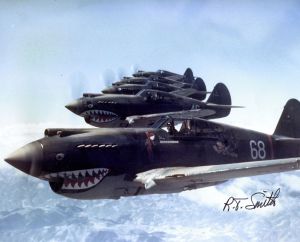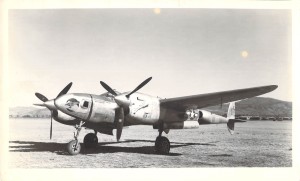
"Arthur Clark's twentieth birthday found him married, a college graduate and enlisted in the Army Air Corps.
This is the story of a three-year post-graduate educational experience which took him around the world as an Air Force intelligence officer."
Seattle Book Company
General Chennault’s Flying Tigers are an icon of the air war against Imperial Japan, as was his Fourteenth Air Force also known by that name. And any hungry tiger on the prowl uses its eyes in hunting, hence the importance of the eyes of the tiger. Certainly Chennault and his air warriors were that kind of hungry tiger.
Curtiss Tomahawk fighters of the 3rd Squadron, 1st American Volunteer Group – “Flying Tigers” over China, photographed in 1942 by AVG pilot Robert T. Smith. (Courtesy Wikipedia)
Soon joining the body of published literature discussing the role of the 35th Photo Reconnaissance Squadron in the China-Burma-India Theater during World War II is Eyes of the Tiger: China 1944-1945, a new book by Major General Arthur W. Clark, USAF (Retired). The 35th PRS served as the “Eyes of the Tiger” in World War II.
Maj. Gen. Arthur W. Clark, USAF (Ret) has written about his wartime experience with the 35th Photo Recon Squadron in the soon to be releasedEyes of the Tiger: China 1944 – 1945. (CourtesyAmazon.com)
General Clark, then a Lieutenant in the Army Air Corps, recounts his experience with the 35th PRS, a unit with origins in the Oregon National Guard’s first aviation unit, the 123rd Observation Squadron, which first activated in Portland, Oregon on 18 April 1941.
After absorbing the sometimes painful and costly lessons learned in the early battles of the war in the Pacific and North Africa, the 123rd was redesignated and repurposed by the Army Air Forces in 1943 as a photo reconnaissance squadron. The squadron trained to operate the Lockheed F-5E Photo Lightning, and prepared to deploy overseas to a combat theater in 1944.
General Clark’s account follows the squadron’s preparation for overseas service, its long journey by ship across the Atlantic Ocean, through the Mediterranean, down the Suez Canal, across the Red Sea and Arabian Sea, arrival in and movement by rail across India, and then by air over the Himalayan Mountains (The Hump ) into China.
A 35PRS F-5E Photo Lightning rests at Yunnanyi Airfield in China, circa late 1944 – early 1945 (Courtesy John Brasko, Jr.)
In China, the 35th PRS established its base at Chanyi and sent flights out to various forward airfields to increase the reach of photographic reconnaissance against the forces and operations of Imperial Japan in China and Southeast Asia. Out there with a forward flight Lt. Clark served as an intelligence officer during 1944 and 1945. He eventually returning to the United States after the end of the war.
His book is now being advertised on Amazon and is a welcome addition to the publications discussing the role of the Lockheed Lightning aircraft in World War II, aerial reconnaissance, the air war in China and the 35th Photo Recon Squadron. A hand salute to General Arthur W. Clark for sharing his wartime experience with the Redhawks of the 35th PRS!




No comments:
Post a Comment